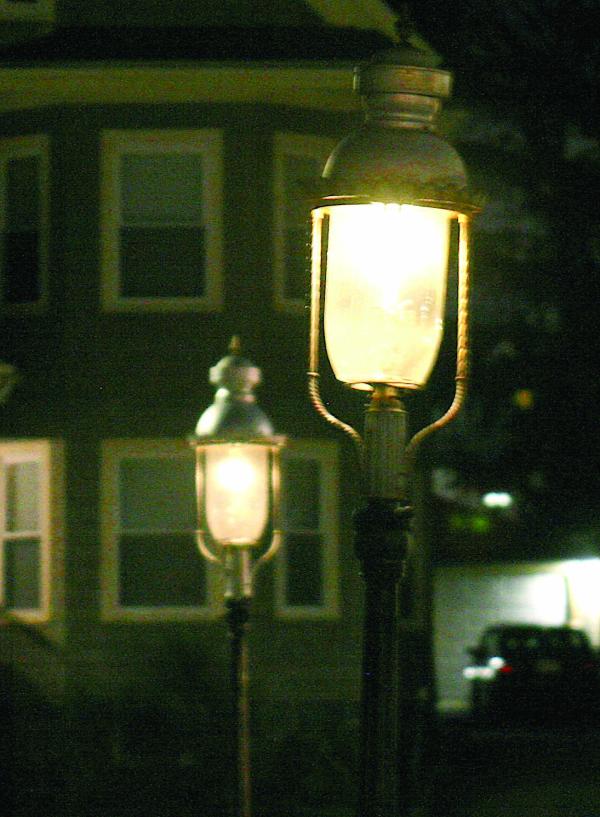April 14, 2022

Two of the twenty-four gas-lit lamps on in Wellesley Park.
Seth Daniel photo
The soft glow of the gas lamps on Wellesley Park signals the preservation of an era long gone for anyone who lives on or passes by this side street of Melville Avenue. It is one of the few streets in Dorchester that have preserved its 19th century gas-lit fixtures.
However, with net-zero emissions a primary goal in Boston’s climate planning, the two dozen lamps are set to be replaced with LED lights via a city project that will also impact neighborhoods like Beacon Hill and Bay Village.
This situation is not sitting well with some Wellesley Park residents.
“These streets that have always maintained their gas lights should be allowed to maintain our gas lights as they are,” said Domenic Accetta, a Wellesley Park neighbor who has kept a close eye on the lights for years. “Replacing these 24 gas lights is not going to affect our carbon footprint at all.”
Accetta points out that while urban renewal projects in the 1970s re-introduced gas lamps to Charlestown, Back Bay, and Beacon Hill, Wellesley Park has never had any other type of streetlight.
“These neighborhoods and areas that have always maintained the gas lighting should be allowed to continue as an historical piece,” he said. “Where that is the case, I think it should be allowed to remain so.”
Other neighbors, like Paul Losordo and Dominique Chouteau, said they are concerned with the color and quality of the proposed replacement lighting. But they also want to hear more about how the historical nature of the neighborhood can be preserved while keeping in mind the city’s environmental initiatives, including the elimination of leaky gas service lines.
“Replacing the illumination source with something more efficient is supportable as long as we are sensitive to its character,” they said in an e-mail. “The gas the current lamps burn is not, in our opinion, a major source of emissions, but they are a visible signal to the community of the city’s commitment to move off fossil fuels.”
The Mayor’s Office said the city’s Municipal Energy team is finalizing contracts to have a citywide lighting audit conducted that will include recommendations on how to get the lighting sector to net-zero emissions. That could include electrifying streetlights in Wellesley Park, as well as a small patch of lights on Rundel Park off of Ashmont Street.
Mayor Wu has indicated there will be no need to choose between historical integrity and sustainability because the city has pledged not to change the character of any neighborhood with a retrofit.
The administration has pointed out that the 2,800 gas lamps in the city, which make up 4 percent of the city’s overall streetlight inventory, account for 37 percent of streetlight greenhouse gas emissions. There are also concerns about frequent, dangerous leaks in the gas lines that supply fuel to the lamps.
Additionally, the administration notes, it costs 90 percent more to power a gas light than an equivalent LED lamp.
The replacement effort has started already in Bay Village, where neighbors and the Boston Landmarks Commission (BLC) have begun looking at live mock-ups of potential LED replacements that are often associated with a “blue” type of light. That has been adjusted in the mock-ups with the use of a LED with a lower light temperature and a change in the lumen output on the lamp.
With blue LED lighting coming in at a temperature of above 3,500 Kelvin – sometimes as high as 5,000 Kelvin – the new streetlights will be using 3,000 Kelvin and 2,500 Kelvin to produce a warmer glow. Lumen adjustments can prevent the lights from being too bright.
The mock-ups at Bay Village contain a type of “mantel” that mimics the way gas lights produce light. Those lights can use existing poles and fixtures.
One negative is that any conversion involves street excavations for gas lines to be removed and electric lines to be installed, an expensive, time-consuming, and disruption to neighborhoods like Wellesley Park.
Residents there point out that there is no electrical service on the street; electricity comes from behind the houses. That would mean digging up the street to exchange the power lines and retrofitting poles and fixtures.
A reconstruction of the street, sidewalks, curbs, and the center-island park was done 15 years ago and things are still in good condition. Neighbors said converting the 24 lights on their street means an awful lot of expense and effort for a small drop in the bucket.
“Replacing these lights is not going to affect the planet; no polar bear is going to die because of our 24 gas lamps,” said Accetta. “It’s an all or nothing proposition it seems, and that’s unfortunate because in all this discussion, there’s not discussion.”


